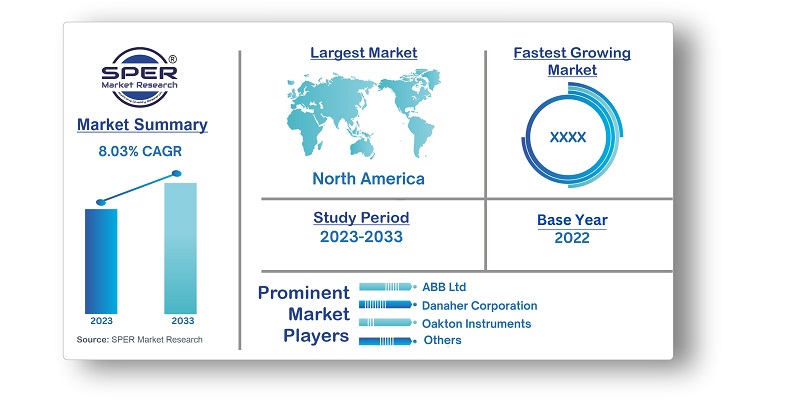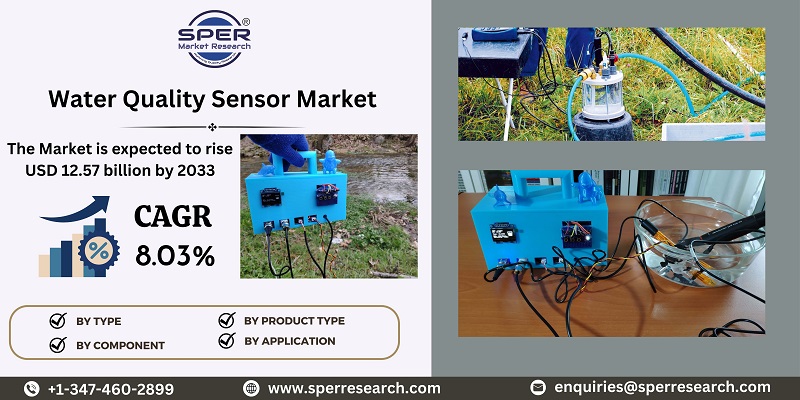
Water Quality Sensor Market Growth, Size, Trends, Demand, Revenue and Future Competition
Water Quality Sensor Market Size- By Type, By Component, By Product Type, By Application- Regional Outlook, Competitive Strategies and Segment Forecast to 2033
| Published: Jul-2023 | Report ID: IACT23138 | Pages: 1 - 224 | Formats*: |
| Category : Information & Communications Technology | |||
- Growing Environmental Concerns: The demand for water quality sensors is being driven by growing knowledge of and worries about water contamination and its effects on the environment. These sensors are essential for monitoring and maintaining water quality because they allow for quick responses to safeguard ecosystems and public health.
- Advancements in sensor technology: including miniaturisation, increased accuracy, and wireless capabilities, are driving the market for water quality sensors to rise. Sensors are now more effective, affordable, and user-friendly which has led to their widespread acceptance.


| Report Metric | Details |
| Market size available for years | 2019-2033 |
| Base year considered | 2022 |
| Forecast period | 2023-2033 |
| Segments covered | By Type, By Component, By Product Type, By Application. |
| Regions covered | Asia-Pacific, Europe, Middle East and Africa, North America, Latin America |
| Companies Covered | ABB Ltd, Danaher Corporation, Horiba, Ltd., Oakton Instruments, Pentair Aquatic Eco-Systems, Inc., Shimadzu Corporation, Thermo Fisher Scientific Inc., YSI Inc., Xylem Inc. |
- Academic and research institutes
- Environmental protection and monitoring agencies
- Food and beverages industries
- Government agencies
- Manufacturers and distributors of water quality monitoring products
- Pharmaceutical and biotechnology industries
- Water pollution monitoring committees
- Water quality monitoring software developers
- Water treatment stakeholders
- Others
| By Type: |
|
| By Component: |
|
| By Product Type: |
|
| By Application: |
|
- Global Water Quality Sensor Market Size (FY’2023-FY’2033)
- Overview of Global Water Quality Sensor Market
- Segmentation of Global Water Quality Sensor Market By Type (Automatic Water Samplers, Colorimeters, Conductivity Meters, Handheld Meters, Multiparameter Sondes, Online/Process Monitors, Single Parameter Sensors, Temperature, Depth Loggers (CTD), Others)
- Segmentation of Global Water Quality Sensor Market By Component (DO Sensors, pH Sensors, Temperature Sensors, Turbidity Sensors, Others)
- Segmentation of Global Water Quality Sensor Market By Product Type (Conductivity Sensors, Dissolved Oxygen Analyzer, TOC Analyzer, Turbidity Meters)
- Segmentation of Global Water Quality Sensor Market By Application (Commercial, Industrial, Laboratories, Residential, Utilities)
- Statistical Snap of Global Water Quality Sensor Market
- Expansion Analysis of Global Water Quality Sensor Market
- Problems and Obstacles in Global Water Quality Sensor Market
- Competitive Landscape in the Global Water Quality Sensor Market
- Impact of COVID-19 and Demonetization on Global Water Quality Sensor Market
- Details on Current Investment in Global Water Quality Sensor Market
- Competitive Analysis of Global Water Quality Sensor Market
- Prominent Players in the Global Water Quality Sensor Market
- SWOT Analysis of Global Water Quality Sensor Market
- Global Water Quality Sensor Market Future Outlook and Projections (FY’2023-FY’2033)
- Recommendations from Analyst
1.1. Scope of the report1.2. Market segment analysis
2.1. Research data source2.1.1. Secondary Data2.1.2. Primary Data2.1.3. SPER’s internal database2.1.4. Premium insight from KOL’s2.2. Market size estimation2.2.1. Top-down and Bottom-up approach2.3. Data triangulation
4.1. Driver, Restraint, Opportunity and Challenges analysis4.1.1. Drivers4.1.2. Restraints4.1.3. Opportunities4.1.4. Challenges4.2. COVID-19 Impacts of the Global Water Quality Sensor Market
5.1. SWOT Analysis5.1.1. Strengths5.1.2. Weaknesses5.1.3. Opportunities5.1.4. Threats5.2. PESTEL Analysis5.2.1. Political Landscape5.2.2. Economic Landscape5.2.3. Social Landscape5.2.4. Technological Landscape5.2.5. Environmental Landscape5.2.6. Legal Landscape5.3. PORTER’s Five Forces5.3.1. Bargaining power of suppliers5.3.2. Bargaining power of buyers5.3.3. Threat of Substitute5.3.4. Threat of new entrant5.3.5. Competitive rivalry5.4. Heat Map Analysis
6.1. Global Water Quality Sensor Market Manufacturing Base Distribution, Sales Area, Product Type6.2. Mergers & Acquisitions, Partnerships, Product Type Launch, and Collaboration in Global Water Quality Sensor Market
7.1. Global Water Quality Sensor Market Value Share and Forecast, By Type, 2023-20337.2. Automatic Water Samplers7.3. Colorimeters7.4. Conductivity Meters7.5. Depth Loggers (CTD)7.6. Handheld Meters7.7. Multiparameter Sondes7.8. Online/Process Monitors7.9. Single Parameter Sensors7.10. Temperature7.11. Others
8.1. Global Water Quality Sensor Market Value Share and Forecast, By Component, 2023-20338.2. DO Sensors8.3. pH Sensors8.4. Temperature Sensors,8.5. Turbidity Sensors8.6. Others
9.1. Global Water Quality Sensor Market Value Share and Forecast, By Product Type, 2023-20339.2. Conductivity Sensors9.3. Dissolved Oxygen Analyzer9.4. TOC Analyzer9.5. Turbidity Meters
10.1. Global Water Quality Sensor Market Value Share and Forecast, By Application, 2023-203310.2. Commercial10.3. Industrial10.4. Laboratories10.5. Residential10.6. Utilities
11.1. Global Water Quality Sensor Market Size and Market Share
12.1. Global Water Quality Sensor Market Size and Market Share By Type (2019-2026)12.2. Global Water Quality Sensor Market Size and Market Share By Type (2027-2033)
13.1. Global Water Quality Sensor Market Size and Market Share By Component (2019-2026)13.2. Global Water Quality Sensor Market Size and Market Share By Component (2027-2033)
14.1. Global Water Quality Sensor Market Size and Market Share By Product Type (2019-2026)14.2. Global Water Quality Sensor Market Size and Market Share By Product Type (2027-2033)
15.1. Global Water Quality Sensor Market Size and Market Share By Application (2019-2026)15.2. Global Water Quality Sensor Market Size and Market Share By Application (2027-2033)
16.1. Global Water Quality Sensor Market Size and Market Share By Region (2019-2026)16.2. Global Water Quality Sensor Market Size and Market Share By Region (2027-2033)16.3. Asia-Pacific16.3.1. Australia16.3.2. China16.3.3. India16.3.4. Japan16.3.5. South Korea16.3.6. Rest of Asia-Pacific16.4. Europe16.4.1. France16.4.2. Germany16.4.3. Italy16.4.4. Spain16.4.5. United Kingdom16.4.6. Rest of Europe16.5. Middle East and Africa16.5.1. Kingdom of Saudi Arabia16.5.2. United Arab Emirates16.5.3. Rest of Middle East & Africa16.6. North America16.6.1. Canada16.6.2. Mexico16.6.3. United States16.7. Latin America16.7.1. Argentina16.7.2. Brazil16.7.3. Rest of Latin America
17.1. ABB Ltd17.1.1. Company details17.1.2. Financial outlook17.1.3. Product Type summary17.1.4. Recent developments17.2. Danaher Corporation17.2.1. Company details17.2.2. Financial outlook17.2.3. Product Type summary17.2.4. Recent developments17.3. Horiba, Ltd.17.3.1. Company details17.3.2. Financial outlook17.3.3. Product Type summary17.3.4. Recent developments17.4. Oakton Instruments17.4.1. Company details17.4.2. Financial outlook17.4.3. Product Type summary17.4.4. Recent developments17.5. Pentair Aquatic Eco-Systems, Inc17.5.1. Company details17.5.2. Financial outlook17.5.3. Product Type summary17.5.4. Recent developments17.6. Shimadzu Corporation17.6.1. Company details17.6.2. Financial outlook17.6.3. Product Type summary17.6.4. Recent developments17.7. Thermo Fisher Scientific Inc.17.7.1. Company details17.7.2. Financial outlook17.7.3. Product Type summary17.7.4. Recent developments17.8. YSI Inc. / Xylem Inc.17.8.1. Company details17.8.2. Financial outlook17.8.3. Product Type summary17.8.4. Recent developments17.9. Others
SPER Market Research’s methodology uses great emphasis on primary research to ensure that the market intelligence insights are up to date, reliable and accurate. Primary interviews are done with players involved in each phase of a supply chain to analyze the market forecasting. The secondary research method is used to help you fully understand how the future markets and the spending patterns look likes.
The report is based on in-depth qualitative and quantitative analysis of the Product Market. The quantitative analysis involves the application of various projection and sampling techniques. The qualitative analysis involves primary interviews, surveys, and vendor briefings. The data gathered as a result of these processes are validated through experts opinion. Our research methodology entails an ideal mixture of primary and secondary initiatives.



Frequently Asked Questions About This Report
PLACE AN ORDER
Year End Discount
Sample Report
Pre-Purchase Inquiry
NEED CUSTOMIZATION?
Request CustomizationCALL OR EMAIL US
100% Secure Payment






Related Reports
Our Global Clients
Our data-driven insights have influenced the strategy of 200+ reputed companies across the globe.






















